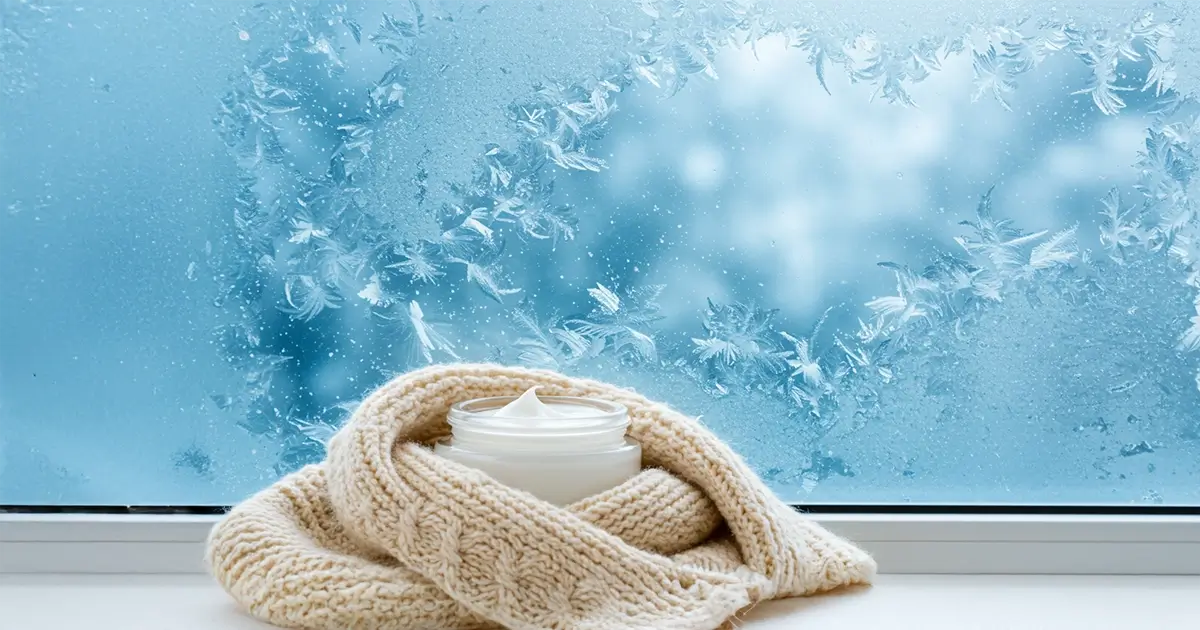Winter winds can leave even the most committed skincare lover feeling like a wilted houseplant, so today I am breaking down how to keep skin calm, comfortable, and noticeably soft when the air outside feels like a moisture vacuum. Expect science-backed tips, ingredient checklists, and lifestyle tweaks you can start tonight - grab a mug of cocoa, this is a 12-minute read.
Why Winter Dries Us Out
The drop in temperature is only half the story, the real villain is humidity that plunges below thirty percent and lets water evaporate from the stratum corneum faster than you can say "snowman." A Columbia University dermatologist notes that cold air strips natural oils, so the skin barrier becomes leaky and dehydrated.
Indoors, radiators and forced-air heaters create desert-like conditions, meaning you face a double hit: icy gusts outside, bone-dry warmth inside. According to the Mayo Clinic News Network, household heating can parch sensitive skin and worsen flaking, unless you add moisture back to the room.
A penguin may waddle around happily at minus ten, yet my cheeks protest after the first block, so please do not compare our skin to Antarctic wildlife.
The Humidity Drop-Off
Water naturally moves from areas of higher concentration (your skin) to lower concentration (the atmosphere). When relative humidity plummets, that gradient grows, accelerating transepidermal water loss. Think of it like leaving the fridge door open in August, eventually everything dries out.
Skin scientists call this desiccation stress, which sounds dramatic because it is. Dehydrated cells shrink and pull apart, creating micro fissures that invite irritants and make lotions sting on contact. Over time, chronic dryness can even trigger low-grade inflammation that speeds up visible ageing.
Indoor Heating Hazards
Central heating often blows recycled air that is low in moisture and high in dust, a combination that can trigger eczema flare-ups and dullness. I run a cool-mist humidifier in my bedroom and keep humidity around forty-five percent although my peace lily would prefer fifty.
Another sneaky culprit is hot showers. That steamy waterfall feels heavenly after a frosty commute, yet prolonged hot water dissolves protective lipids, exaggerating tightness the moment you towel off. Keep the shower brief, lukewarm, and pat - not rub - skin dry.
Finally, chilly winds and icy rain physically batter exposed skin. Wind increases convective heat loss, which means skin temperature falls quickly, blood vessels constrict, and the barrier receives less nutrient-rich circulation.
Building a Defensive Routine
Now, here comes the fun part: crafting a routine that fights back against harsh winter air. Everything starts with gentle cleansing, generous moisturizing, and strategic sealing of water, yet smart selection of actives and treatments adds an extra layer of resilience.
Cleanse Kindly
I swap foaming gels for creamy, pH-balanced cleansers rich in fatty acids. These formulas lift grime without stripping oils, so my face never squeaks - squeaky skin is dehydrated skin in disguise.
If you use potent actives like retinoids or exfoliating acids, buffer with a hydrating toner. Over-exfoliation in winter is like sanding a wooden table during a blizzard, it invites cracks and splinters.
Moisturize Like You Mean It
Dermatologists recommend ingredients that perform three jobs: humectants draw water in, emollients smooth the gaps, and occlusives lock everything down. A Harvard Health article singles out glycerin, urea, and petrolatum as barrier champions.
Timing matters more than texture. I pat on my moisturizer within sixty seconds of cleansing, while skin is still slightly damp, so the humectants have water to grab. Two thin layers often beat one thick layer because the first layer hydrates and the second seals.
- Humectants: glycerin, hyaluronic acid, sodium PCA
- Emollients: squalane, shea butter, jojoba esters, cholesterol
- Occlusives: petrolatum, dimethicone, lanolin, mineral oil
Seal and Protect Overnight
If my cheeks feel sandpaper rough, I finish with a pea-sized smear of petrolatum. This technique, sometimes called slugging, is not new; dermatologists have used ointment occlusion for decades because it reduces overnight water loss by almost seventy percent.
For hands and feet, I slather a ceramide balm, pull on cotton gloves or socks, and let the occlusion work while I dream of sun-drenched holidays.
Choose Your Actives Wisely
Winter does not mean abandoning brightening or anti-age goals, it simply requires pacing. I halve my retinoid frequency and switch glycolic acid for lactic acid, a gentler alpha hydroxy that doubles as a humectant.
Spot treatments with benzoyl peroxide can be extra drying, so I layer a thin gel only on blemish-prone zones and follow with a barrier cream everywhere else.
Barrier-Repair Extras
Niacinamide at five percent strengthens ceramide production and calms redness, making it a perfect morning serum. Peptides support collagen, yet many formulas include hydrating bases that feel cushiony on cold days.
Panthenol, a provitamin of B5, not only attracts water but also reduces transepidermal loss over time, so look for it high on the ingredient list.
Smart Lifestyle Tweaks
No product can fully compensate if daily habits sabotage moisture, so I make small adjustments that add up to big comfort.
First, showers: five minutes, lukewarm water, gentle cleanser, end scene. Long hot soaks feel therapeutic but they rinse away cholesterol and ceramides that hold cells together.
Second, fabrics: I love my chunky wool jumper, yet it scratches like an untrained kitten. I wear a breathable cotton layer underneath and skip fabric softeners that contain fragrance which can irritate compromised skin.
- Run a humidifier nightly and clean it twice a week to dodge mold growth.
- Drink water for overall vitality, though topical measures hydrate skin more directly.
- Snack on omega-3-rich foods - salmon, flaxseed, chia - because healthy lipids reinforce the barrier from within.
- Keep a travel-size cream in your bag to reapply after every hand wash and before you put on gloves.
- Lower indoor thermostat slightly; moderate warmth feels cosy without wicking moisture as aggressively.
Nutrition and Supplements
A diet rich in vitamin C, zinc, and polyphenols supports collagen formation and fights oxidative stress induced by cold, windy conditions. My favourite winter bowl features roasted pumpkin, chickpeas, and a drizzle of tahini for zinc.
If your diet lacks oily fish, consider an algae-based omega-3 supplement, especially if you follow a plant-forward menu. Always check with your healthcare provider before adding new pills.
Remember, skin cells turn over roughly every twenty-eight days, so dietary changes show on the surface after a month or two. Be patient and view nutrition as an ongoing investment during the long winter months.
Hydration Hacks
When plain water starts to taste boring, I switch to warm infusions of ginger, lemon, and a spoonful of honey; the steam alone feels like a mini facial. Herbal options like rooibos supply antioxidants without caffeine, so late night sips will not steal your sleep.
I also eat my water by loading soups with leafy greens and sweet potatoes. High water-content produce contributes to overall hydration, and the slow simmer releases minerals that support skin metabolism.
Mind the Lips and Hands
Lips lack oil glands, so they are first to crack. Swap wax heavy sticks for ointment style balms that contain petrolatum or lanolin, and reapply every two hours when skiing or hiking. Avoid licking, saliva evaporates fast and worsens dryness.
Hands face constant washing. After every cleanse, I press a pea sized dollop of glycerin cream into the backs of my hands, then clasp them together like I am warming up at a campfire. At night, cotton gloves lock in the treatment and keep greasy fingerprints off my phone screen.
Don't Skip Sunscreen
Snow reflects up to eighty percent of ultraviolet, so exposure can rival a day at the shore. I stick with broad spectrum SPF thirty or above and reapply before my lunchtime walk even if the sky looks like concrete.
Modern formulas feel feather light, and tinted mineral screens even the complexion, so there is no excuse. Consistent sunscreen prevents hyperpigmentation that becomes more noticeable against winter-pale skin.
Professional Treatments to Consider
If winter leaves your face feeling like sandpaper, short, low-energy laser resurfacing or a gentle lactic acid peel performed by a dermatologist can reset the surface without excessive downtime. Ask for post-procedure barrier masks rather than fragranced lotions; they soothe and hydrate instantly.
Microneedling with platelet-rich plasma sounds futuristic, yet studies show it boosts collagen and barrier lipids over several weeks. Schedule sessions at least a month apart so the skin has time to rebuild between treatments.
Emergency Fixes for Sudden Flare-Ups
Despite diligence, harsh gusts or a surprise ski trip can spark redness and flaking overnight. My emergency kit includes single-use ampoules of one percent hydrocortisone for spot treatment and thermal spring water spray to soothe sting without creating mess.
If cracks bleed, I dab a petrolatum-based ointment and cover with a hydrocolloid patch to keep microbes out while the barrier knits itself together. Avoid picking at flakes - think of them as tiny roof shingles, lifting them pulls at healthy tiles around them.
Persistent itching or oozing warrants professional evaluation. Dermatologists can prescribe stronger topicals or patch testing to rule out contact allergy to metals in scarf clasps or fragrance in detergent.
FAQ
Do I need a different moisturizer in winter?
Probably yes. Lotions that feel perfect in July often lack enough oil for January. Switch to a cream or ointment if skin feels tight by midday, or if fine lines look sharper after cleansing.
Is petroleum jelly safe for acne prone skin?
Petrolatum is non comedogenic, meaning it sits on top rather than clogging pores. Apply it as a thin layer over a lighter moisturizer, and avoid massaging it into already congested areas.
How often should I exfoliate when the air is cold?
Once or twice a week with a mild chemical exfoliant is plenty. Over exfoliation compromises the barrier and increases redness that takes longer to fade in winter.
Can I rely on drinking water alone to hydrate skin?
Internal hydration is essential for every cell, yet external moisturization still matters because water escapes faster in low humidity environments.
Do I really need sunscreen if daylight is short?
Yes. UVA rays penetrate clouds and glass, so daily protection prevents cumulative damage even on grey afternoons.
Where can I learn about layering products correctly?
Check out my step by step layering guide to build a season proof routine that feels luxurious, not complicated.
Conclusion
Harsh winter air may feel relentless, yet with smart tweaks - gentle cleansing, richer moisturizers, indoor humidity control, a nutrient dense diet, and faithful sunscreen - you can keep your skin resilient and comfortable until the crocuses bloom.
Share your favourite cold weather trick in the comments, and let me know which tip you will try first. See you in the next post - until then, take good care of your skin!


Comments (0)
No comments yet - be the first to share your thoughts!
Leave a Reply
Your email address will not be published. Required fields are marked *